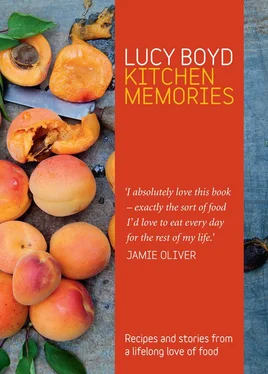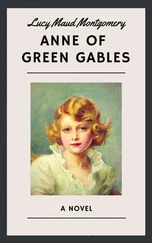The young new lamb is often quite pale in colour and needs less time to cook than mature lamb. I love using the shoulder joint, which is delicious roasted slowly on the bone; the fatty juices that are released keep the flesh tender and full of flavour.
New peas and broad beans, freshly podded, add a note of refreshing vibrancy. Podding the beans is a huge part of the enjoyment – sitting at a table with a glass of wine, easing the beans out of their pods is a pleasure in itself that does not compare to opening a bag of frozen broad beans with their dull grey skins, the beans all the same size, graded to within an inch of their lives.
1 shoulder of new season’s lamb (it should be quite small, about 2kg), or ½ shoulder of mature lamb
4–5 garlic cloves, peeled and cut into fine slivers
2 sprigs of fresh rosemary, leaves picked from their stems, washed and dried
300ml red wine
1kg peas in the pod
1kg broad beans in the pod
about 2 tbsp extra-virgin olive oil
1 sprig of fresh garden mint, washed and dried
salt and black pepper
Preheat the oven to 220ºC (200ºC fan) Gas 7. Using a small, sharp knife, make little slits about mm deep into the lamb shoulder, about 5cm apart. Put a sliver of garlic (reserving some for the peas and beans) and a couple of rosemary leaves into each slit and season well with salt and pepper. Put the rest of the garlic to one side. Put the lamb in a flameproof roasting tin, cover with foil and put in the oven for 40 minutes, then remove the foil, turn the oven down to 200ºC (180ºC fan) Gas 6 and cook for a further 2–3 hours, adding a slosh of wine every now and again. How long depends on the size of your shoulder, so check after hour of cooking. About minutes before you take the lamb out, pour a final generous glass of wine into the bottom of the roasting tin. Transfer the lamb to a warm dish, cover with a sheet of silver foil and let it rest for 20 minutes.
While the lamb is cooking, pod the peas and broad beans and put in separate bowls. Put a pan of water on to boil with a pinch of salt and blanch the peas for 5 minutes, then drain. Blanch the broad beans in a separate pan of boiling, unsalted water for 4–5 minutes, then drain.
Heat a good drizzle of extra-virgin olive oil in a pan and add the reserved garlic slivers. As they become sticky and start to colour, add the broad beans and peas and toss together, then season with salt and pepper. I add a whole sprig of fresh mint, which I remove when I am ready to serve, as it blackens with the heat from the beans and peas.
Skim off any fat from the juices in the roasting tin and add more wine, if needed. Put on the hob and let it bubble and reduce, then pour into a bowl or small pan to keep it hot.
Pull the meat away from the bone in pieces and serve with the peas and broad beans and the juices from the pan.
I serve this with piping-hot potato gratin, which is very simple and quick to make ( see here).
POTATO GRATIN WITH PARMESAN
FOR 4
20g unsalted butter
300ml double cream
1kg waxy potatoes, peeled and cut lengthways into 3mm slices, then rinsed with cold water
2–3 garlic cloves, peeled and finely chopped
60g freshly grated Parmesan cheese
olive oil
salt and black pepper
Preheat the oven to 200ºC (180ºC fan) Gas 7. Lightly butter an ovenproof dish.
Put the cream in a saucepan large enough to contain the potatoes and bring to a simmer. Add the potato slices and stir together with the cream. Add the garlic and season with salt and pepper. Cook for about minutes, then pour into the prepared dish, sprinkle the Parmesan over with a small drizzle of olive oil, cover with silver foil and place in the oven. Cook for minutes or so until the potatoes are cooked through, then remove the foil and return to the oven. Turn the oven up to 200ºC (200ºC fan) Gas and cook for a further 15–20 minutes until the top is bubbling and golden.

UGLY BISCUITS … BRUTTI MA BUONI; UGLY BUT GOOD
I love the simplicity of this recipe. These light, Mediterranean biscuits are perfect with an espresso after a meal or with a peaches and cream ice cream, or simply on their own as a sweet biscuit for the children. If you want to make half the quantity, just halve the ingredients.
4 medium egg whites
250g caster sugar that has been kept in a jar with a vanilla pod (or add ½ tsp vanilla extract)
300g skinned whole almonds, finely chopped (not to a powder) in a food processor or by hand in the pestle and mortar
Preheat the oven to 170ºC (150ºC fan) Gas 3. Whip the egg whites with a pinch of sugar until very stiff. Mix the almonds with the remaining sugar (and the vanilla extract, if using) and fold in the egg whites.
Grease a baking sheet (or use a non-stick baking tray liner), as they are quite sticky. Using a tablespoon, place little dollops about 3–4cm apart (they spread a little when cooking), onto the baking sheet and bake for 30 minutes. Remove from the oven and leave to firm up on the tray and dry out a little, then transfer to a wire rack to cool. They can keep for a while in a tin but are so good they will soon be devoured.
One year at Petersham I decided to grow edible annual flowers between the usual flowers we grew for cutting – dahlias, zinnias, scabious, cosmos and sweet peas amongst others, none of which are edible but which were chosen for their cut-and-come-again abilities as well as for their ornamental virtues. I also planted endless roses, the petals and hips of which are edible. My boss at Petersham, Francesco, would walk past me and say, ‘Roses, more roses, I want the whole place filled with roses.’
For edible flowers, I sowed seeds of blue and white borage (which over the years has continued to self-sow), sweet rocket, nasturtiums, malope, calendula and violas, amongst others. My good friend Skye Gyngell loves to use flowers in her cooking and so the rocket was allowed to bolt and flower along with the coriander. Francesco thought this an example of sloppy gardening practice – which it is if you don’t want rocket or borage seeding itself all over the place.
Skye is naturally inquisitive in her approach to cooking and has an intuitive sense of flavours that go well together. Rose petals were stolen to use in salads for the Petersham café kitchen and the blossom from the rosemary bushes picked along with the usual squash and courgette flowers. I even tried to grow caper plants for their flowers and buds but without much success – they need a long, hot growing season. Perhaps some seed artfully dropped into the rough hogging that makes up the dusty floor in one of the glasshouses would succeed. It might be perfectly happy in a sunny, neglected spot; my stepfather, David, grows them in pots in his sun-filled flat very successfully. The plant sprawls away on the windowsill, producing a mass of dense green leaves with beautiful little buds and flowers.
RECIPE FOR A PLATE OF FRIED FLOWERS AND BUDS – ARTICHOKES, CAPERS AND BORAGE
FOR 4
4 whole artichokes (‘Violetto’ are a good variety for this)
1½ lemons
30g salted capers, rinsed, soaked in a bowl of water with a splash of red wine vinegar for minutes (or capers from a jar, rinsed and dried)
8 stems of borage with the flowers and leaves attached, washed and patted dry and the ends trimmed
150ml sunflower oil, for frying
2 tbsp plain flour (for dusting)
Читать дальше













